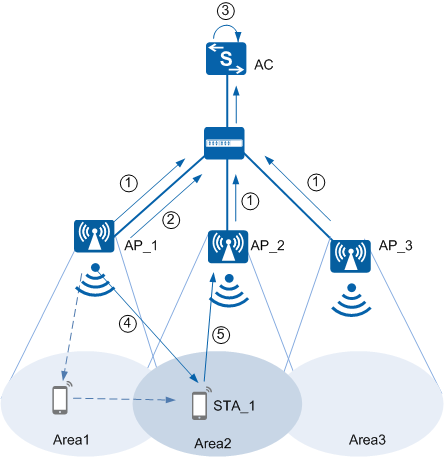Smart Roaming
Overview
Some terminals on networks have low roaming aggressiveness. As a result, they stick to the initially connected APs regardless of whether they move far from the APs, and have weak signals or low rates. The terminals fail to roam to neighboring APs with better signals. They are called sticky terminals.
- Poor service experience: The terminals stick to weak-signal APs, causing a sharp decrease in the wireless channel rate.
- Channel performance degradation: The terminals have poor signals or low rates, and frequent packet loss and retransmissions occur. As a result, the terminals occupy the wireless channels for a long time, which prevents terminals with good signals from using the wireless channel for enough time.
Smart roaming addresses the problems. After smart roaming is configured, the system actively steers the terminals to neighboring APs with better signals.
Improved performance
- Common coverage scenarios: The smart roaming function allows terminals with poor signals to roam to better APs. The service experience of the terminals and overall wireless channel performance are therefore improved.
- High-density coverage scenarios: Terminals usually have good signals in the scenarios but may not connect to the optimal APs. The smart roaming function allows the terminals to associate with the optimal APs, which greatly improves the wireless channel performance.
Traffic load balancing
With smart roaming, each terminal associates with the nearest AP, enabling APs to load balance traffic.
Implementation
An AP collects terminal information, discovers neighboring APs, and periodically reports the terminal and neighbor information to the AC.
Neighboring APs can be discovered in the following modes:- The AP listens on Probe frames of terminals.
- The AP periodically switches working channels to scan terminals.
- If the Beacon report mechanism of the 802.11k protocol is used, terminals report the detected neighboring APs.
The AC maintains a terminal neighbor table based on the information reported by APs. The terminal neighbor table records the neighboring APs of each terminal and the corresponding SNR.
When STA_1 associates with AP_1, AP_1 collects the SNR and rate of STA_1 in real time and determines whether STA_1 is a sticky terminal. If STA_1 is a sticky terminal, AP_1 reports the terminal to the AC.
AP_1 considers STA_1 a sticky terminal if the AP detects that the signal strength of STA_1 remains lower than the threshold in a certain period.
In Figure 1, STA_1 moves from Area1 to Area2. AP_1 detects that the signal strength of STA_1 is lower than the threshold in a specified period of time and considers STA_1 a sticky STA.
After receiving the reported information, the AC selects the optimal neighboring AP of STA_1 (AP_2) as the target AP to which STA_1 is to roam and delivers the target AP information to AP_1.
The AC determines the target AP to which a sticky terminal is to roam as follows:- The AC checks the terminal neighbor table and selects neighboring APs whose SNR exceeds that of the AP currently associated with the terminal based on the specified threshold. The selected neighboring APs are candidate APs to which the terminal is to roam.
- Among all candidate APs, the AC selects the optimal AP based on the STA's SNR, rate and load balancing information, and then triggers terminal roaming.
To prevent frequent terminal roamings due to terminal movements or signal fluctuations, terminal roaming is triggered only when the terminal is detected a sticky terminal for three consecutive times.
AP_1 forces STA_1 to roam to AP_2 based on the BSS transition mechanism defined in the 802.11v protocol or the forced logout mode.
When roaming STA_1 disassociates from AP_1, AP_1 suppresses the association request from STA_1 temporarily to prevent STA_1 from connecting to AP_1 again.
STA_1 roams to AP_2.
Due to individual differences, some terminals do not roam to APs with better signals but stick to the initially associated APs even if they are disconnected forcibly. These terminals may not initiate association requests if forced offline. The AC will record these terminals unable to roam. When an "unable to roam" terminal is classified as a sticky terminal, the AP does not trigger roaming of the terminal in a specified period to prevent service interruption.
